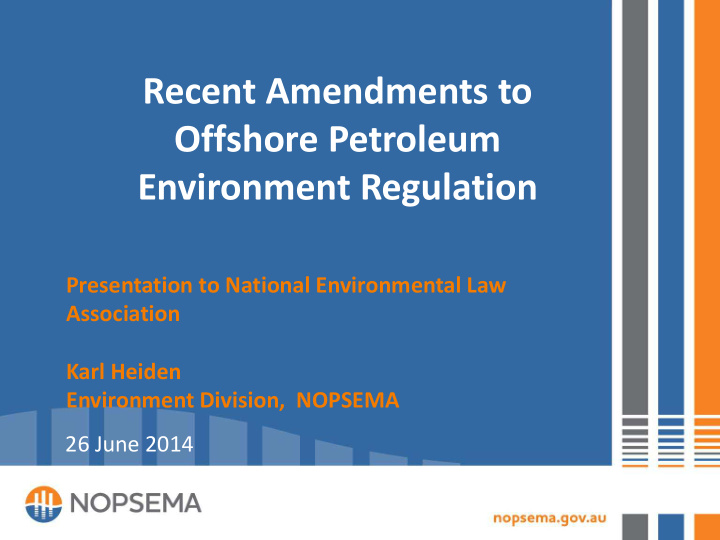



Recent Amendments to Offshore Petroleum Environment Regulation Presentation to National Environmental Law Association Karl Heiden Environment Division, NOPSEMA 26 June 2014
Overview • Background to OPGGS (Environment) Regulation amendments – Montara Commission of Inquiry – Environment Regulation Review – Streamlining regulatory processes • Key regulatory amendments • Other legislative amendments • What it means - improved environmental outcomes 2
Background - Montara CoI • Montara well-head blow-out – 21 August 2009, well-kill 3 November. • Government established Commission of Inquiry – reported 17 June 2010 3
Background - Montara • Government accepted or noted 102 of 105 recommendations – Strong support of an ‘objective-based’ regime – Improvements in monitoring of impacts – Stronger accountability for titleholder 4
Environment Regulations Review • OPGGS (Environment) Regulations – first enacted 1999 (as PS(LA) Env Regulations) • Department of Industry review in 2012 • Issues Paper released for industry and public comment – end 2012 • Key themes: – Titleholder responsible for submission and compliance with EP – Clarified content requirements of EP – Greater transparency in assessment process 5
Regulatory Streamlining • Part of broader Government agenda to reduce regulatory burden • Task force established October 2013 • Strategic assessment under EPBC Act with goal to endorse NOPSEMA’s environmental authorisation regulatory process • Key objectives: – Reduced duplication and overlap in regulatory approvals processes – Increased clarity and certainty in decision-making processes – Retaining strong environmental safeguards 6
Key regulatory amendments • Clarification of titleholder obligations • Titleholder responsible for all aspects of EP compliance - not activity operator • EP content requirements clarified • Oil Pollution Emergency Plan contents + testing • Monitoring over life of activity and during pollution incident • Transparency of assessment • Titleholder and activity information published on submission of EP • EP summary must contain response to consultation 7
Key regulatory amendments • Clarification of requirements for environmental performance and incident reporting • Including provision of reportable incident reports to Titles Administrator and State/Territory • Strengthening of requirements for oil pollution emergency planning • Name change to align with OPRC convention • Reinforcement and clarification of response, testing and monitoring arrangements • Strengthening environmental requirements • No planned activities within a World Heritage property • Submission of Offshore Project Proposal 8
Other legislative amendments • Strengthening of requirements relating to: – Polluter pays principle via financial assurance amendments to OPGGS Act • Potential for subsequent regulatory amendments to further clarify requirements – Compliance measures amendments to OPGGS Act • single class of NOPSEMA inspector, increased and enhanced range of tools available to secure compliance 9
Environmental Outcomes • Improved preparedness to respond to incidents • Clarification of requirements to monitor effects of oil pollution • Environmental regulatory requirements – clarified, simplified and consolidated • Duties and responsibilities of titleholders - clarified and strengthened 10
Environmental Outcomes • Removed duplication in environmental regulation, strong environmental safeguards remain • Referral of offshore petroleum activities under the EPBC Act NOT required • Improved transparency in decision making • Strengthened requirements for engagement with effected parties (relevant persons) • Titleholders have clarity, certainty and consistency in their engagement with the Commonwealth 11
Questions? Background • Key legislative amendments • Outcomes for environment and • industry
Recommend
More recommend